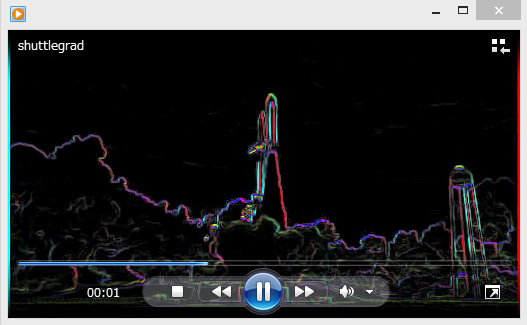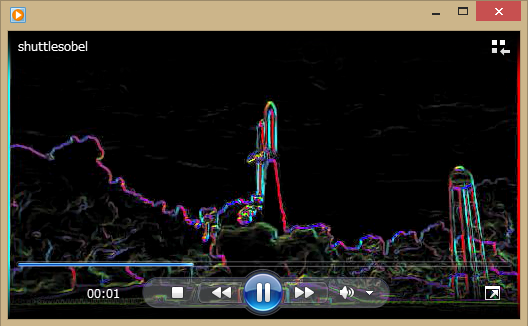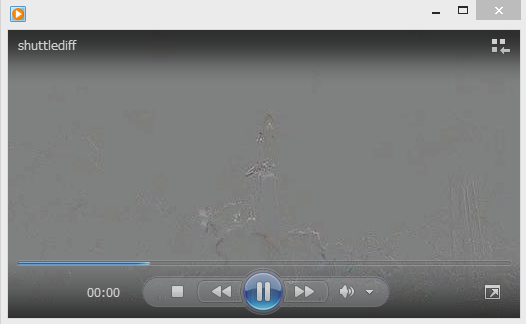EmbVision Tutorial: Part 4
Video Stream Processing - MATLAB -
Shogo MURAMATSU and Yuki TAKAHASHI
Niigata Univ.
Copyright (c), All rights reserved, 2014-2025, Shogo MURAMATSU
Contents
Summary
Through this exercise, you can learn how to read, display and write videos. As well, you can also experiment simple video stream processing.
As a preliminary, close all figures by using function CLOSE
close all
Video Read
To read a video from a file, MATLAB provides the READFRAME method in VIDEOREADER class.
vrObj = VideoReader('shuttle.avi');
frame = readFrame(vrObj);
Variable frame stores the first frame of the video data.
Because "shuttle.avi" is RGB color video, variable frame becomes 3-D array.
In not specified, the data type becomes unsigned 8 bit.
whos vrObj frame
Name Size Bytes Class Attributes frame 288x512x3 442368 uint8 vrObj 1x1 8 VideoReader
Let us display the frame.
In order to use later, prepare the handle object of IMSHOW.
figure(1) hi1 = imshow(frame);

Note that variable vrObj is an instance object of VideoReader class and stores the information on the video as properties.
The followings summarize the main properties.
- BitsPerPixel: Bits per pixel [bpp]
- FrameRate: Frame rate [bps]
- Height: height [pixels]
- Width: width [pixels]
properties(vrObj)
クラス VideoReader に対するプロパティ:
Duration
Name
Path
BitsPerPixel
FrameRate
Height
NumFrames
VideoFormat
Width
Tag
UserData
CurrentTime
Thus, the properties such as the height, width and frame rate are obtained as follows.
height = get(vrObj,'Height'); width = get(vrObj,'Width'); frameRate = get(vrObj,'FrameRate');
Calling the READFRAME method reads next frame.
By overwriting the frame data to the CData property of IMSHOW handle object hi1, the contents is updated.
frame = readFrame(vrObj);
set(hi1,'CData',frame);

[ Top ]
Video Display
Let us set property "CurrentTime" of vrObj to 0 and display all of the frames.
In order to force to show every frame in the WHILE loop, one can adopt the DRAWNOW function.
The HASFRAME method enables us to detect whether the current frame is the last or not.
set(vrObj,'CurrentTime',0); while (hasFrame(vrObj)) frame = readFrame(vrObj); set(hi1,'CData',frame); end

As another way, the MOVIE function also displays videos. For the detail, refer to the document.
[ Top ]
Video Write
MATLAB realizes the video write function by the WRITEVIDEO method of the VIDEOWRITER class.
Let us rewind the CurrentTime property to 0 and write a video to AVI file named "shuttleclone.avi."
set(vrObj,'CurrentTime',0); vwObj = VideoWriter('shuttleclone.avi'); properties(vwObj)
クラス VideoWriter に対するプロパティ:
Duration
Filename
Path
FileFormat
VideoBitsPerPixel
FrameRate
VideoCompressionMethod
Height
Quality
VideoFormat
ColorChannels
Width
FrameCount
set(vwObj,'FrameRate',frameRate); open(vwObj) while (hasFrame(vrObj)) frame = readFrame(vrObj); writeVideo(vwObj,frame); end close(vwObj)
Then, the video is written to AVI file "shuttleclone.avi."
The saved AVI file can be played by a tool outside MATLAB.

[ Top ]
Video Processing
By inserting a frame processing between reading and writing a frame, one can realize a video stream processing.
Here, let us create a video by applying the gradient filter created in Exercise Part 3 to every frame. Recall the following three System object classes.
- Rgb2GraySystem
- Hsv2RgbSystem
- GradFiltSystem
First, instantiate System objects for the frame processing as
rgsObj = Rgb2GraySystem(); hrsObj = Hsv2RgbSystem(); gfsObj = GradFiltSystem();
Then, rewind the CurrentTime property of vrObj to zero and prepare an AVI file "shuttlegrad.avi" to save the output video.
set(vrObj,'CurrentTime',0); vwObj = VideoWriter('shuttlegrad.avi'); set(vwObj,'FrameRate',frameRate); open(vwObj)
Start the video processing.
while (hasFrame(vrObj)) frame = readFrame(vrObj); % Read frame graysc = step(rgsObj,frame); % Convert to grayscale [mag,ang] = step(gfsObj,graysc); % Apply gradient filtering ang = (ang+pi)/(2*pi); % Normalize the direction mag = min(mag,1); % Saturate the magnitude [r,g,b] = step(hrsObj,ang,mag,mag); % Convert to pseudo color frame = cat(3,r,g,b); % Concatenate to RGB array writeVideo(vwObj,frame); % Write frame end close(vwObj)
After finishing the process, the result will be saved in to the AVI file named "shuttlegrad.avi."

[ Top ]
Inter Frame Processing (Option)
It is possible to define a System object class which stores past frames.
In order to create a new class, FrameAveSystem, which produces average frames between successive two input frames, let us prepare the following test case class, FrameAveSystemTestCase.
classdef FrameAveSystemTestCase < matlab.unittest.TestCase %FRAMEAVESYSTEMTESTCASE Test Case for FrameAveSystem properties end methods (Test) function testFirstFrame(testCase) % Preparation width = 12; height = 16; % Input frame frame1 = rand(height,width,3); % Expectations cnt0Expctd = []; cnt1Expctd = 1; res1Expctd = frame1; % Instantiation of the target obj = FrameAveSystem(); % Verify the initial state state = getDiscreteState(obj); cnt0Actual = state.Count; testCase.verifyEqual(cnt0Actual,cnt0Expctd) % Actual values res1Actual = step(obj,frame1); state = getDiscreteState(obj); cnt1Actual = state.Count; % Verify the actual values testCase.verifyEqual(res1Actual,res1Expctd,'RelTol',1e-6) testCase.verifyEqual(cnt1Actual,cnt1Expctd) end function testThreeFrames(testCase) % Preparation width = 12; height = 16; % Input frames frame1 = rand(height,width,3); frame2 = rand(height,width,3); frame3 = rand(height,width,3); % Expectations cnt1Expctd = 1; cnt2Expctd = 2; cnt3Expctd = 3; res1Expctd = frame1; res2Expctd = (frame1+frame2)/2; res3Expctd = (frame2+frame3)/2; % Instantiation of the target obj = FrameAveSystem(); % Actual values of the process for the first frame res1Actual = step(obj,frame1); state = getDiscreteState(obj); cnt1Actual = state.Count; % Actual values of the process for the second frame res2Actual = step(obj,frame2); state = getDiscreteState(obj); cnt2Actual = state.Count; % Actual values of the process for the third frame res3Actual = step(obj,frame3); state = getDiscreteState(obj); cnt3Actual = state.Count; % Verify the actual values testCase.verifyEqual(cnt1Actual,cnt1Expctd) testCase.verifyEqual(cnt2Actual,cnt2Expctd) testCase.verifyEqual(cnt3Actual,cnt3Expctd) testCase.verifyEqual(res1Actual,res1Expctd,'RelTol',1e-6) testCase.verifyEqual(res2Actual,res2Expctd,'RelTol',1e-6) testCase.verifyEqual(res3Actual,res3Expctd,'RelTol',1e-6) end function testReset(testCase) % Preparation width = 12; height = 16; % Input frame frame1 = rand(height,width,3); % Expectations cnt0Expctd = []; cnt1Expctd = 1; cntrExpctd = 0; % Instantiation of the target obj = FrameAveSystem(); % Verify the initial state state = getDiscreteState(obj); cnt0Actual = state.Count; testCase.verifyEqual(cnt0Actual,cnt0Expctd) % Verify the state after processing for the first frame step(obj,frame1); state = getDiscreteState(obj); cnt1Actual = state.Count; testCase.verifyEqual(cnt1Actual,cnt1Expctd) % Verify the state after reset reset(obj); state = getDiscreteState(obj); cntrActual = state.Count; testCase.verifyEqual(cntrActual,cntrExpctd) end end end
The following is an example of the FrameAveSystem class that satisfies the above test case class, FrameAveSystemTestCase.
classdef FrameAveSystem < matlab.System properties preFrame % Previous frame end properties (DiscreteState) Count % Frame count end properties (Access = private) end methods (Access = protected) % Setup (evaluated just before the first call of STEP) function setupImpl(obj,srcFrame) % Initialization of the previous frame obj.preFrame = srcFrame; % Initialization of the frame count obj.Count = 0; end % Step function resFrame = stepImpl(obj,srcFrame) % Taking average of frames resFrame = (obj.preFrame + srcFrame)/2; % Update the previous frame by the current one obj.preFrame = srcFrame; % Increment the frame count obj.Count = obj.Count+1; end % Reset function resetImpl(obj) % Reset the frame count obj.Count = 0; end end end
result = run(FrameAveSystemTestCase);
FrameAveSystemTestCase を実行しています ... FrameAveSystemTestCase が完了しました __________
An example script of using the FrameAveSystem class is shown below.
fasObj = FrameAveSystem(); set(vrObj,'CurrentTime',0); vwObj = VideoWriter('shuttleave.avi'); set(vwObj,'FrameRate',frameRate); open(vwObj) while (hasFrame(vrObj)) frame = readFrame(vrObj); % Read frame frame = im2double(frame); % Convert to double type frame = step(fasObj,frame); % Take average of frames writeVideo(vwObj,frame); % Write frame end close(vwObj)
After finishing the process, the result will be saved in to the AVI file named "shuttleave.avi."

[ top ]
Exercises
Exercise 4-1. Sobel Gradient Filter
Instantiate a gradient filter object
gfs = GradFiltSystem('Kernel',[ 1 2 1 ; 0 0 0 ; -1 -2 -1 ]);
by using vertical differential filter coefficients
 ,
,
and horizontal differential filter coefficients
 .
.
Then, apply the following process to video "shuttle.avi."
graysc = step(rgsObj,frame); % Convert to grayscale [mag,ang] = step(gfsObj,graysc); % Apply gradient filtering ang = (ang+pi)/(2*pi); % Normalize the direction mag = min(mag,1); % Saturate the magnitude [r,g,b] = step(hrsObj,ang,mag,mag); % Convert to pseudo color frame = cat(3,r,g,b); % Concatenate to RGB array
Save the result to AVI file "shuttlesobel.avi."
(Example Answer)

Exercise 4-2. Frame Difference (Option)
Implement a class named "FrameDiffSystem," which produces difference between successive frames so that the following test case passes.
classdef FrameDiffSystemTestCase < matlab.unittest.TestCase %FRAMEDIFFSYSTEMTESTCASE Test Case for FrameDiffSystem properties end methods (Test) function testFirstFrame(testCase) % Preparation width = 12; height = 16; % Input frame frame1 = rand(height,width); % Expectations cnt0Expctd = []; cnt1Expctd = 1; res1Expctd = zeros(height,width); % Instantiation of the target obj = FrameDiffSystem(); % Verify the initial state state = getDiscreteState(obj); cnt0Actual = state.Count; testCase.verifyEqual(cnt0Actual,cnt0Expctd) % Actual values res1Actual = step(obj,frame1); state = getDiscreteState(obj); cnt1Actual = state.Count; % Verify the actual values testCase.verifyEqual(res1Actual,res1Expctd,'RelTol',1e-6) testCase.verifyEqual(cnt1Actual,cnt1Expctd) end function testThreeFrames(testCase) % Preparation width = 12; height = 16; % Input frames frame1 = rand(height,width); frame2 = rand(height,width); frame3 = rand(height,width); % Expectations cnt1Expctd = 1; cnt2Expctd = 2; cnt3Expctd = 3; res1Expctd = zeros(height,width); res2Expctd = (frame2-frame1); res3Expctd = (frame3-frame2); % Instantiation of the target obj = FrameDiffSystem(); % Actual values of the process for the first frame res1Actual = step(obj,frame1); state = getDiscreteState(obj); cnt1Actual = state.Count; % Actual values of the process for the second frame res2Actual = step(obj,frame2); state = getDiscreteState(obj); cnt2Actual = state.Count; % Actual values of the process for the third frame res3Actual = step(obj,frame3); state = getDiscreteState(obj); cnt3Actual = state.Count; % Verify the actual values testCase.verifyEqual(cnt1Actual,cnt1Expctd) testCase.verifyEqual(cnt2Actual,cnt2Expctd) testCase.verifyEqual(cnt3Actual,cnt3Expctd) testCase.verifyEqual(res1Actual,res1Expctd,'RelTol',1e-6) testCase.verifyEqual(res2Actual,res2Expctd,'RelTol',1e-6) testCase.verifyEqual(res3Actual,res3Expctd,'RelTol',1e-6) end function testReset(testCase) % Preparation width = 12; height = 16; % Input frame frame1 = rand(height,width); % Expectations cnt0Expctd = []; cnt1Expctd = 1; cntrExpctd = 0; % Instantiation of the target obj = FrameDiffSystem(); % Verify the initial state state = getDiscreteState(obj); cnt0Actual = state.Count; testCase.verifyEqual(cnt0Actual,cnt0Expctd) % Verify the state after the process for the first frame step(obj,frame1); state = getDiscreteState(obj); cnt1Actual = state.Count; testCase.verifyEqual(cnt1Actual,cnt1Expctd) % Verify the state after reset reset(obj); state = getDiscreteState(obj); cntrActual = state.Count; testCase.verifyEqual(cntrActual,cntrExpctd) end end end
(Example Answer)
result = run(FrameDiffSystemTestCase);
FrameDiffSystemTestCase を実行しています ... FrameDiffSystemTestCase が完了しました __________
vrObj = VideoReader('shuttle.avi'); frameRate = get(vrObj,'FrameRate'); vwObj = VideoWriter('shuttlediff.avi'); set(vwObj,'FrameRate',frameRate); fdfObj = FrameDiffSystem(); open(vwObj) while (hasFrame(vrObj)) frame = readFrame(vrObj); % Frame input frame = im2double(frame); % Convert to double type frame = step(fdfObj,frame); % Frame difference frame = frame/2+0.5; writeVideo(vwObj,frame); % Frame output end close(vwObj)
